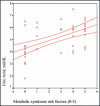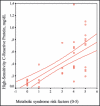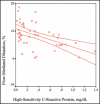High inflammatory activity related to the number of metabolic syndrome components
- PMID: 20167041
- PMCID: PMC8673215
- DOI: 10.1111/j.1751-7176.2009.00229.x
High inflammatory activity related to the number of metabolic syndrome components
Abstract
It has been known that each component of the metabolic syndrome (MS) has an atherogenic potential and increases the risk of cardiovascular events. Therefore, patients who have MS are candidates for the development of atherosclerosis and accompanying complications. In this study, the authors assessed the levels of acute phase reactants as an indicator of inflammation in patients with MS. Twenty-five patients with recently diagnosed MS and not treated before who had at least 3 of 5 diagnostic criteria of MS listed in the Third Report of the Adult Treatment Panel National Cholesterol Education Program (NCEP-ATP III) guidelines were included in the study. Twenty healthy patients constituted the control group. Inflammatory parameters were compared between the groups. There was no significant difference between the MS and control group with regard to age and sex. White blood cell count (/mm(3)), high-sensitivity C-reactive protein (hs-CRP), uric acid, interleukin (IL) 6, and fibrinogen levels were found to be significantly higher in the MS group. Number of MS components was strongly correlated with serum levels of hs-CRP (r=0.688, P=.0001), IL-6 (r=0.546, P=.0001), fibrinogen (r=0.551, P=.0001), uric acid (r=0.517, P=.0001), and leucocyte count (/mm(3)) (r=0.456, P=.002). Inflammation plays an important role in atherosclerotic complications, which is activated in MS. Increased number of MS components are strongly associated with elevated inflammatory and metabolic markers. Measurement of serum inflammatory parameters in patients with MS may be beneficial in detection and management of cardiovascular events and in the assessment of efficacy of treatment.
Figures







Similar articles
-
Uric acid as a link between renal dysfunction and both pro-inflammatory and prothrombotic state in patients with metabolic syndrome and coronary artery disease.Kardiol Pol. 2011;69(4):319-26. Kardiol Pol. 2011. PMID: 21523662
-
Association between serum uric acid, high sensitive C-reactive protein and pro-oxidant-antioxidant balance in patients with metabolic syndrome.Biofactors. 2018 May;44(3):263-271. doi: 10.1002/biof.1424. Epub 2018 Apr 11. Biofactors. 2018. PMID: 29638023
-
Relation of high-sensitivity C-reactive protein, interleukin-6, tumor necrosis factor-alpha, and fibrinogen to abdominal adipose tissue, blood pressure, and cholesterol and triglyceride levels in healthy postmenopausal women.Am J Cardiol. 2005 Jul 1;96(1):92-7. doi: 10.1016/j.amjcard.2005.02.051. Am J Cardiol. 2005. PMID: 15979442
-
Homocysteine is the confounding factor of metabolic syndrome-confirmed by siMS score.Drug Metab Pers Ther. 2018 Jun 27;33(2):99-103. doi: 10.1515/dmpt-2017-0013. Drug Metab Pers Ther. 2018. PMID: 29624500
-
High-sensitivity C-reactive protein and atherosclerotic disease: from improved risk prediction to risk-guided therapy.Int J Cardiol. 2013 Oct 15;168(6):5126-34. doi: 10.1016/j.ijcard.2013.07.113. Epub 2013 Aug 24. Int J Cardiol. 2013. PMID: 23978367 Review.
Cited by
-
Interleukin-18 can predict pre-clinical atherosclerosis and poor glycemic control in type 2 diabetes mellitus.Int J Appl Basic Med Res. 2011 Jul;1(2):109-12. doi: 10.4103/2229-516X.91155. Int J Appl Basic Med Res. 2011. PMID: 23776788 Free PMC article.
-
Association between serum magnesium concentration and metabolic syndrome, diabetes, hypertension and hyperuricaemia in knee osteoarthritis: a cross-sectional study in Hunan Province, China.BMJ Open. 2018 Sep 10;8(9):e019159. doi: 10.1136/bmjopen-2017-019159. BMJ Open. 2018. PMID: 30206073 Free PMC article.
-
Association between Dietary Magnesium Intake and Hyperuricemia.PLoS One. 2015 Nov 4;10(11):e0141079. doi: 10.1371/journal.pone.0141079. eCollection 2015. PLoS One. 2015. PMID: 26536119 Free PMC article. Clinical Trial.
-
Why Does Hyperuricemia Not Necessarily Induce Gout?Biomolecules. 2021 Feb 14;11(2):280. doi: 10.3390/biom11020280. Biomolecules. 2021. PMID: 33672821 Free PMC article. Review.
-
Association between high-sensitivity C-reactive protein and hyperuricemia.Rheumatol Int. 2016 Apr;36(4):561-6. doi: 10.1007/s00296-016-3429-z. Epub 2016 Feb 10. Rheumatol Int. 2016. PMID: 26862048
References
-
- Expert Panel on Detection, Evaluation, and Treatment of High Blood Cholesterol in Adults . Executive Summary of the Third Report of the National Cholesterol Education Program (NCEP) (Adult Treatment Panel III). JAMA. 2001;285:2486–2497. - PubMed
-
- Festa A, D’Agostino R, Howard G, et al. Choronic subclinical inflammation as part of the insulin resistance syndrome The Insulin Resistance Study (IRAS). Circulation. 2000;102:42–47. - PubMed
-
- Ross R. Atherosclerosis‐an inflammatory disease. N Engl J Med. 1999;340:115–126. - PubMed
-
- Hansson G, Libby P. The Role of the Lymphocyte: Atherosclerosis and Coronary Artery Disease. New York, NY: Lippincott Raven. 1997;557–568.
-
- Libby P, Simon DI. Inflammation and thrombosis: the clot thickens. Circulation. 2001;103:1718–1720. - PubMed
Publication types
MeSH terms
Substances
LinkOut - more resources
Full Text Sources
Medical
Research Materials
Miscellaneous

